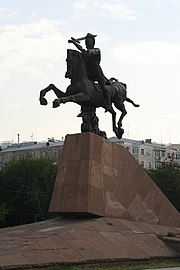| Vardan Mamikonian | |
|---|---|
 Vardan Mamikonian illustration in 1898 book «Illustrated Armenia and Armenians» [1] | |
| Born | 393 |
| Died | 451 (aged 57–58) |
| Rank | Sparapet |
| Battles/wars | Battle of Avarayr |

The statue of Vardan Mamikonian in Yerevan
Vardan Mamikonian (Armenian language: Վարդան Մամիկոնյան ) (393 AD — 451 AD), also known as Saint Vardan (Սուրբ Վարդան Surb Vardan) was an Armenian military leader, a martyr and a saint of the Armenian Church. Vardan Mamikonian, a member of the Mamikonian family, is revered as one of the greatest military and spiritual leaders of Christian Armenia in the 5th century. Saint Vardan Day, usually in February (rarely at times in first week of March but always falling on a Thursday), is commemorated by churches in Armenia and the Armenian diaspora. He is considered a national hero.[2][3][4][5] Major Armenian churches are named after Saint Vardan. A major equestrian statue representing him is found in the Armenian capital Yerevan.
Biography[]
- Birth
Vardan Mamikonian was born in 393 AD to Hamazasp Mamikonian (in Armenian Համազասպ Մամիկոնյան) and to Sahakanoush (in Armenian Սահականուշ),
- Life
After Vardan became Sparapet (army leader) in 432, the Persians summoned him to Ctesiphon. Upon his return home in 450, Vardan repudiated the Persian religion and instigated an Armenian rebellion against their Sassanian overlords. Vardan died in the Battle of Avarayr on the Avarayr Plain in Vaspurakan. The also known as the Battle of Vardanants, was fought on May 26, 451 AD on the Avarayr Plain in Vaspurakan, between the Armenian Army under Saint Vardan and the Sassanid (Persian) rulers. While the Persians were victorious on the battlefield itself, with Vardan killed in battle, the Battle of Avarayr paved the way for the compact between Persians and Armenians that guaranteed religious freedom for Christian Armenians.
- After death
After his death, the insurrection continued led by Vahan Mamikonian, the son of Vardan's brother, resulting in the restoration of Armenian autonomy with the Nvarsak Treaty (484), thus guaranteeing the survival of Armenian statehood in later centuries.
- Family
Vardan Mamikonian is the father of Vardeni Mamikonian (known also as (Armenian language: Շուշանիկ , Georgian language: შუშანიკი ) transliterated as Shushanik or Shoushanig), born around 409 AD. She married Varsken of Georgia. When her husband, a prominent Georgian feudal lord (pitiakhsh) Varsken took a pro-Persian position renouncing Christianity and adopting Zoroastrianism, he tried to force his wife Shushanik to convert, but she refused vehemently to submit to his orders to abandon her Christian faith and was put to death in 475 AD on Varsken's orders. Shushanik has been canonized by the Georgian Orthodox and Apostolic Church and is venerated by the Armenian Apostolic Church. Known as Saint Shushanik, her feast day is celebrated on October 17.
Veneration[]
After his death, Vardan Mamikonian was consecrated as a saint of the Armenian Apostolic Church. He is commonly known as Saint Vardan (in Armenian Սուրբ Վարդան) (in Eastern Armenian transliteration and pronunciation Surb Vardan, in Western Armenian transliteration and pronunciation as Saint Vartan or Sourb Vartan).
He is also revered by the Armenian Catholic Church as a saint of the church and by Armenian Evangelical Church.
His commemoration day in the official Armenian Church calendar is usually in the month of February and on very rare occasions may fall in the first week of March. The actual Saint Vardan day is a moving day, as it always has to fall on a Thursday.
Major Christian Armenian churches are named after Saint Vardan, including St. Vartan Cathedral in New York City.
Vardan and Western Armenian variant Vartan are both very common given names for Armenian males, the female version is Vardanoush or Vartanoush. Vardanyan, Vardanian, and Vartanian are also common Armenian family names.
References[]
- ↑ Vardan Mamikonian illustration in 1898 book «Illustrated Armenia and Armenians» [1]
- ↑ J. Gordon Melton, Martin Baumann (2010). Religions of the World, Second Edition: A Comprehensive Encyclopedia of Beliefs and Practices (2nd ed. ed.). Santa Barbara, California: ABC-CLIO. p. 183. ISBN 9781598842043.
- ↑ Suny, Ronald Grigor (1993). Looking toward Ararat Armenia in modern history. Bloomington: Indiana university press. p. 4. ISBN 9780253207739.
- ↑ Angela Harutyunyan, Kathrin Hörschelmann, Malcolm Miles (2009). Public spheres after socialism. Bristol, UK: Intellect. p. 22. ISBN 9781841502120.
- ↑ Robert Armot, Alfred Aghajanian (2007). Armenian literature: comprising poetry, drama, folklore, and classic traditions. Los Angeles, CA: Indo-European Pub.. p. 5. ISBN 9781604440003.
The original article can be found at Vardan Mamikonian and the edit history here.